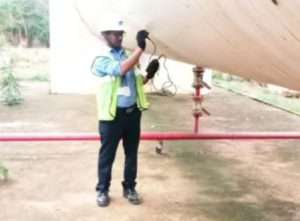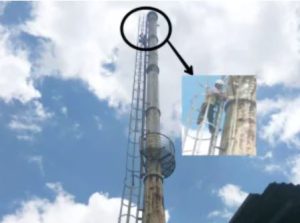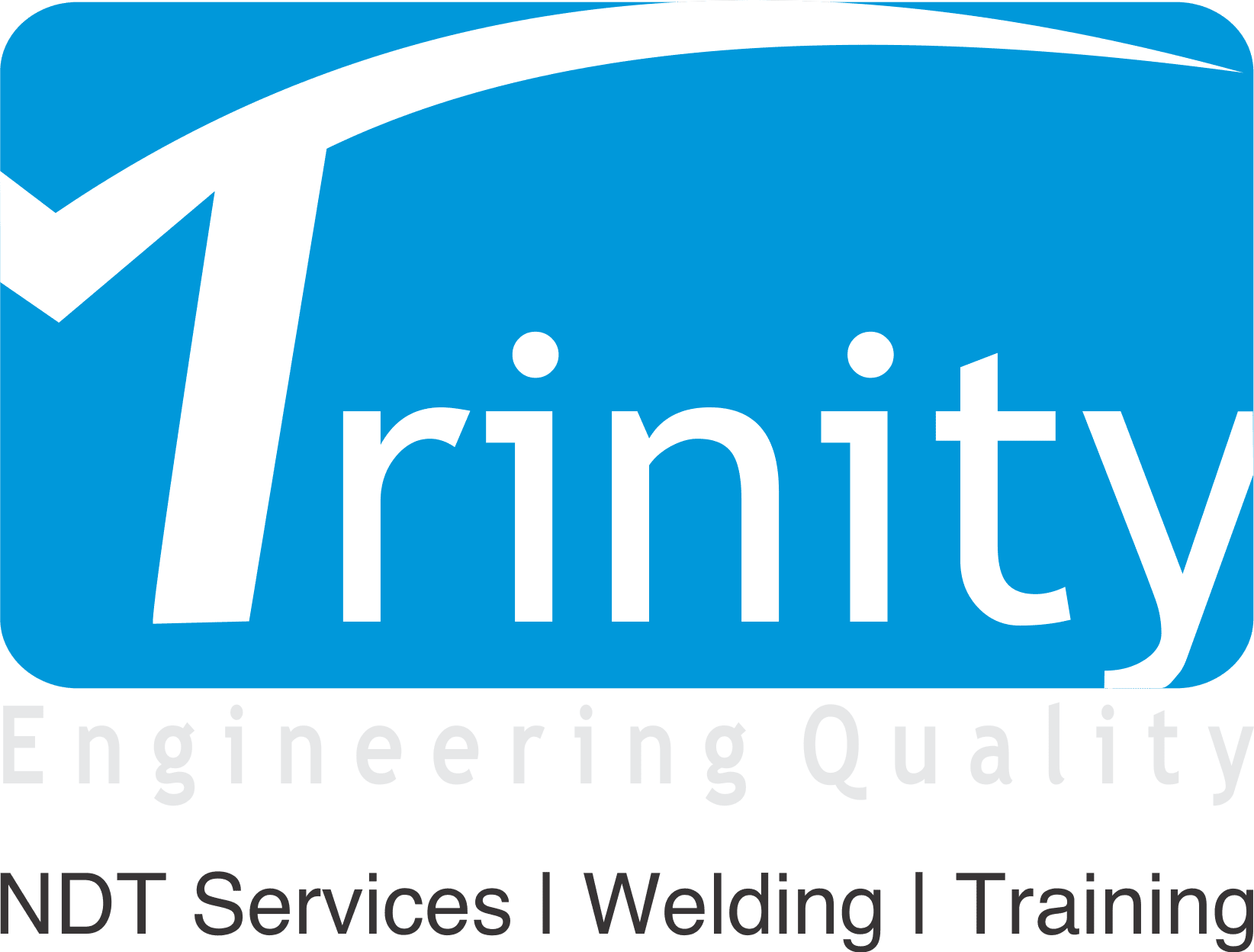Ultrasonic Thickness Gauging Service. NABL Accredited.
UTG Level II Certified Experienced Inspectors. In-house ASNT Level III Experts.
Digital Ultrasonic Thickness Testing. Chimneys, Pipelines, Bridges And Boiler Pipe Wall Thickness.
Ultrasonic Thickness Measurement Services in Bangalore. Digital UTG for pipelines, chineys and boiler tubes. NABL accredited Lab.
Digital Ultrasonic Thickness Gauging (UTG) Services

Measuring existing thickness through the cross section is used to determine loss of wall attributed to corrosion. This gives an indication of degradation level. Our Ultrasonic thickness gauging service helps in condition monitoring of Chimneys, Boiler pipes and tubes. Inspection for corrosion can range from simple measurement to detailed corrosion mapping using C-scan images. It is important to monitor the structures and processing plants to maintain safety and reliability.
Metals especially steels are subjected to corrosion during usage of parts. Corrosion is phenomenal if the environment is conducive for it. Chemical, acidic surrounding accelerated the rate of wall thickness loss. Even some times the losses are exponential, the pipes and tubes may leak and structures may fail to bear the load.
Ultrasonic thickness tests are used extensively on basic shapes and products of many materials, on precision machined parts, and to determine wall thinning in process equipment caused by corrosion and erosion.
Boiler Pipes, Tubes, Pressure Vessels Corrosion testing
Boiler pipes and tubes are required to be bent to suit the design. While bending, the outer wall expands and inner wall compresses. In the earlier days, if for example 100 Nos of tubes are to be bent, then, 101 Nos. or more tubes are processed. One or more tubes are randomly selected to be cut at the bent portion to see the wall thickness loss due to expansion. The sectional thickness is measured using vernier or micrometer. This is a destructive means of testing for tube wall thickness. The limitation is risk involved in choosing sample as it may not actually resemble all the tubes under inspection.
With the advent of Digital Ultrasonic thickness gauging, it is possible to measure the wall thickness using nondestructive means. This not only eliminated the risk in sample selection, this helped to test all the boiler tubes in the lot with greater amount of accuracy. Above all, the speed of thickness inspections using Ultrasonic method tremendously improved the productivity.
Boiler tubes are exposed to hot gases and moisture borne air thus leading to loss of wall thickness. It is quite common that because of small leakage of these tubes, the whole plant need to forcibly shut down. Leading to high economic losses to the organizations that do not do planned maintenance inspections. Managements have become smarter and introduced Ultrasonic thickness gauging. Now, almost all power plants, refineries, steel plants and other process companies use in-service wall thickness testing using Digital Ultrasonic thickness gauges.
Avoid Leakages Due to Loss of Tube Thickness
Historical industrial accidents are identified to be caused due to poor maintenance practices. These pipes and tubes might have been installed long ago. Subjected to severe cyclic mechanical or thermal cycling, the structures are obviously becomes weak. Finally as the wall thickness is reduced to a point where the sections can’t able to bear the load and thus fails suddenly.
Major Industrial accidents such as Bhopal Gas leakage or the recent poisonous gas leakage from a process plant in Visakhapatnam in Andhra Pradesh questions the safety, integrity of our plants and structures. This also stress upon the need for periodic maintenance and monitoring of critical structures and pipelines for possible wall thickness reductions. Global warming related changes in the environments are posing challenges to the corrosion experts.
Considering the above, it is evident that periodically monitoring the pipe lines and structures is vital for safely and reliability of plants. Ultrasonic thickness gauges can measure the wall thickness, helps in monitoring the trend of corrosion.
Chimney Wall Thickness Testing

Chimneys are installed to expel the exhaust gases and smoke. Majority of these smoke emitting Chimneys may have the height of above 100meters. These are subjected to severe corrosion both due to smoke passing through it and the environment. The only means of ensuring the integrity is by measuring remaining wall thickness. As they bear heavy loads, wind and drafts, they shall be able to withstand the conditions.
Digital Ultrasonic thickness gauging shall be planned and performed to check the condition. This helps to asses the remaining life of the section under inspection. Usually wall thickness for lower sections near the ground is high when compared to the walls at greater heights. Continuous monitoring of wall thickness helps in replacing the corroded sections in time.
Measuring the wall thickness of these Chimneys is required using Digital Ultrasonic thickness gauging equipment. Accuracy of these equipment is quite impressive and can go up to 0.001mm or better. The accuracy of these gauges depends on
- surface condition,
- calibration procedure,
- temperature of the component and
- type of couplant used.
Pulse Echo type Ultrasonic thickness gauging equipment are generally used for thickness measurements. These machines operates from 500 KHz to 100MHz range.
Suitable Materials for UTG Service
Wide varieties of materials are possible to be tested using ultrasonic thickness gauging (UTG).
These include metals, plastics, glass, ceramics, epoxies and composites. Number of other applications include:
-Verifying component thickness when access to the back side is impossible
-Inspecting material loss due to wear and/or corrosion
-Testing material thickness with an accuracy of plus or minus 0.001mm
Virtually any material in which ultrasonic waves can pass through at constant velocity and back wall echo can be obtained are ultrasonic tested for wall thickness.
How UTG Works? Working Principle
Pulsed echo Ultrasonic thickness gauging determine the wall thickness of the component b measuring the time required for short ultrasonic pulse generated by a transducer to travel through the thickness.
The amount of time it takes for the sound to transmit through the part, reflect from the back surface and return to the probe is divided by two in order to account for the down and back sound path distance. This is multiplied by the sound velocity of the material. This is converted to digital display and can be recorded for future reference.
Thickness (T), when measured by the pulse-echo ultrasonic method, is a product of the velocity of sound in the material and one half the transit time (round trip) through the material.
T = V x t/2
where:
T = thickness,
V = velocity, and
t = transit time.
The pulse-echo ultrasonic instrument measures the transit time of the ultrasonic pulse through the part. The velocity in the material being examined is a function of the physical properties of the material.
Probe Accessories available with us for service
Typically Transmitter-Receiver (T-R) Type probes are used for Ultrasonic thickness gauging. Due to use of different crystals for transmitting and receiving these are also called as dual beam or double crystal transducers. When a dual crystal transducer is used, the ringing of the transducer crystal is not detected by the instruments.
This allows signals close to the initial pulse to be clearly resolved.
A plastic delay tip is bonded to the front side face of the probe element which separates the initial pulse from the front face signal. This helps to improve the transducers near surface resolution, thereby shortening the dead zone and improvement in measurement accuracy.
Reference Standards for Calibration
To ensure precise measurements, it’s crucial to have one or more reference blocks with known velocities or made of the same material as the specimen under examination. These reference blocks should have their thicknesses accurately measured, ideally falling within the range of the thicknesses to be measured.
When selecting reference blocks for your measurements, it’s advisable to aim for ’round number’ thickness values rather than using miscellaneous odd values. Additionally, including one reference block with a thickness near the maximum of the desired range and another near the minimum thickness can enhance measurement accuracy.
Two reference standards are required. one 50 – 90% of the nominal thickness to be measured and one 110 – 150% of the nominal thickness to be measured.The thickness of the reference standard shall be measured mechanically or optically. Some procedures state that the maximum tolerance for these measurements shall be one-half the tolerance permitted for the ultrasonic thickness measurements on the test part.
In other words, if the test part needs to be tested withing a tolerance of plus or minus 0.254mm, then the thickness of the reference standards should have tolerance plus or minus 0.127mm.
If the part measurement tolerance is not specified in the NDT procedure, the reference standards should be measured withing plus or minus 0.127mm or one-half the instrument tolerance, whichever is greater.
A test part can be used as reference standard if it meets the surface finish requirements and two or more ares on the test part can be measured mechanically or optically.
Qualification of personnel
If your contractual agreement mandates it, the personnel conducting Ultrasonic thickness inspection must possess qualifications aligned with nationally or internationally recognized standards.
Qualifications for NDT personnel must adhere to recognized industry practices or standards, such as ANSI/ASNT CP-189, SNT-TC-1A, NAS-410, ISO 9712, or a comparable document. These qualifications should be officially certified by either the employer or a relevant certifying agency such as ‘Trinity Institute of NDT Technology‘. The institute offers special training course on Ultrasonic Thickness Gauging. After completion, the trainees can get certification in Ultrasonic thickness gauging Level II as per ASNT SNT TC 1A or ISO9712.
The contractual agreement between the parties involved should explicitly specify the chosen NDT personnel qualification practice or standard, along with its relevant revision, to ensure compliance and consistency in the certification process.
Out technicians are certified to ASNT SNT TC 1A Level II in Ultrasonic Thickness Testing. With over two decades of gauging experience they will perform testing at heights of chimneys and airport structures.
About Our Labs at Trinity NDT WeldSolutions Pvt. Ltd.
When it comes to ensuring the structural integrity of your assets, precision and accuracy are paramount. Trinity NDT understands this need and offers a comprehensive Ultrasonic Thickness Gauging service designed to meet and exceed your expectations.
On-Site Services:
Our highly trained and certified technicians bring the expertise and technology directly to your location. Whether you have complex industrial equipment, pipelines, or storage tanks, our on-site services deliver accurate thickness measurements without the need for dismantling or transportation. This approach minimizes downtime, saving you time and money while ensuring the safety and reliability of your assets.
In-Lab Services:
For projects that require a controlled environment, our state-of-the-art laboratory facilities in Bangalore, India are at your disposal. Trinity NDT Labs‘ controlled conditions and cutting-edge equipment guarantee precise measurements and data analysis. This option is ideal for smaller components, samples, or situations where on-site testing may not be feasible.
NABL Accreditation – Trinity NDT Labs for Ultrasonic Thickness Measurements:
At Trinity NDT Labs, we take quality seriously. Our commitment to excellence is demonstrated by our ISO17025:2017 accreditation from the National Accreditation Board for Testing and Calibration Laboratories (NABL). This accreditation signifies our compliance with stringent international standards, assuring you of the highest quality and reliability in our services.
Our skilled team of experts is proficient in utilizing advanced ultrasonic thickness gauging equipment to provide you with accurate, dependable results. We understand that the integrity and safety of your assets are of paramount importance, and we are dedicated to assisting you in achieving your goals.
Trust Trinity NDT for all your Ultrasonic Thickness Gauging needs, and experience the difference that precision, expertise, and NABL accreditation can make. Contact us today to discuss your specific requirements and discover how we can be your partner in ensuring the longevity and safety of your assets.
You can also Whats app us your requirement by clicking below link.
Frequently Asked Questions (FAQs)
In general, Ultrasonic thickness gauging is performed for surface temperatures not to exceed 93°C (200 °F). For surface exceeding this requires specially designed high temperature probes and specially formulated couplants.
High-temperature materials, up to about 540°C [1000°F], can be measured with specially designed instruments with high-temperature compensation, search unit assemblies, and couplants.
A decrease in sound velocity would result in the sound pulse taking longer to return to the transducer. This would result in a thickness reading much higher when material is at higher temperature.
Is there any surface finish requirement?
The most accurate thickness measurement is obtained when the front and back surface of the component are smooth and parallel. If the surface is rough, the minimum thickness that can be measured will be increased. This is due to the sound reverberating in the increased thickness of the couplant layer.
If either surface of the component is rough, the returning Ultrasonic echo could be distorted. This is due to the slightly different sound paths identified by the transducer. All foreign material which could interfere with the precise measurement should be removed.
The surface prior to thickness measurements shall be free of loose scale, paint, dust, dirt, oil, grease or any other extraneous matter that may affect the measurement accuracy. For this, the pre-examination surface preparation criteria shall be specified in the contractual agreement.
Note that if you are performing an inspection with a rough surface, this will effect acoustic coupling between the probe and the part under inspection. A rough surface on the reflected side will also effect the accuracy of the thickness reading.
What is ‘doubling’ in UTG?
On thin materials, Ultrasonic thickness gauges can display readings which are twice or three times the actual material thickness being measured. This commonly is called ‘Doubling’. Occur below the minimum specified thickness range of the transducer. If the probe is worn doubling can occur at thickness greater than the minimum specified range.
The accuracy of the any thickness measurement is only as good as the accuracy of the calibration. Most ultrasonic gauges provide a method for calibrating for the sound velocity and zero offset using reference standards made of the same material or similar acoustic properties.
What is the standard applicable for thickness testing?
Unless Other wise specified any other standard, we follow, ASTM E797 – Standard Practice for Measuring Thickness by Manual Ultrasonic Pulse-Echo Contact Method.
Inspectors are capable to perform as per ISO 16809:2017 – Nondestructive testing Ultrasonic Thickness Measurement.
What is the cost of service for UTG?
At Trinity NDT, we understand that pricing transparency is essential for our clients. Our Ultrasonic Thickness Gauging service is competitively priced, with rates starting as low as Rs. 1000/- at our labs in Peenya Industrial Area, Bangalore.
However, it’s important to note that our pricing is flexible and varies based on several factors, including the choice between in-lab and on-site services, the number of measurement points required. Also varies as per the height and complexity of the component being tested, the location of testing, and other specific project requirements. We take pride in offering customized solutions to meet your precise needs while ensuring cost-effectiveness. Contact us today for a personalized quote tailored to your unique project specifications.
Check our other NDT Services
- NABL accredited NDT testing service
- Radiography x-ray testing
- Eddy Current testing
- Ultrasonic Testing UT Service
- Magnetic particle inspection
- Demagnetization service
- Dye penetrant Testing
- Visual Welding Inspection
- ASNT, NAS410 Level III consulting
- Welder Qualification certification
- Certification courses on NDT and Welding
- Aerospace NDT Services
- NADCAP accredited Aerospace Labs

